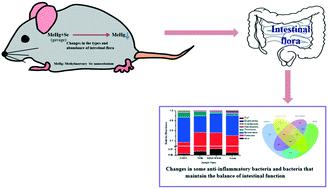当前位置:
X-MOL 学术
›
Environ. Sci.: Nano
›
论文详情
Our official English website, www.x-mol.net, welcomes your
feedback! (Note: you will need to create a separate account there.)
Using nanoselenium to combat Minamata disease in rats: the regulation of gut microbes
Environmental Science: Nano ( IF 5.8 ) Pub Date : 2021-4-1 , DOI: 10.1039/d1en00267h Yang Liu 1, 2, 3, 4, 5 , Wei Zhang 5, 6, 7, 8, 9 , Jiating Zhao 10, 11, 12, 13, 14 , Xiaoying Lin 5, 10, 11, 15, 16 , Liming Wang 10, 11, 12, 13, 14 , Liwei Cui 10, 11, 12, 13, 14 , Junfang Zhang 5, 9, 17 , Bai Li 10, 11, 12, 13, 14 , Yu-Feng Li 10, 11, 12, 13, 14
Environmental Science: Nano ( IF 5.8 ) Pub Date : 2021-4-1 , DOI: 10.1039/d1en00267h Yang Liu 1, 2, 3, 4, 5 , Wei Zhang 5, 6, 7, 8, 9 , Jiating Zhao 10, 11, 12, 13, 14 , Xiaoying Lin 5, 10, 11, 15, 16 , Liming Wang 10, 11, 12, 13, 14 , Liwei Cui 10, 11, 12, 13, 14 , Junfang Zhang 5, 9, 17 , Bai Li 10, 11, 12, 13, 14 , Yu-Feng Li 10, 11, 12, 13, 14
Affiliation

|
Methylmercury (MeHg) can magnify through food chains and cause potent neurological problems like Minamata disease. Gut microbes have been found to demethylate MeHg while MeHg can destroy the diversity of gut microbes. Our recent study found that selenite (Se4+) could promote the demethylation of MeHg and regulate the diversity of gut microbes in MeHg-poisoned rats (Minamata disease). Elemental selenium at nano-size (nanoSe) was less toxic than Se4+ with comparable bioavailability. In this study, nanoSe was studied on its demethylation of MeHg and regulation of gut microbes in rats with Minamata disease using Se4+ as a positive control. Rats with Minamata disease were treated with nanoSe or Se4+ every other day for 90 days. Fecal samples were collected on days 8, 30, 60 and 90, and concentrations of Se, Hg and MeHg were measured. The diversity and abundance of gut microbes were determined using 16S rRNA gene profiling. It was found that both nanoSe and Se4+ enhanced the demethylation of MeHg, especially before day 30. The percentage of MeHg (of total mercury) in the MeHg-poisoned group was in the range of 81–105% while it was 23–79% in the nanoSe group and 65–84% in the Se4+ group, suggesting the higher demethylation rate of nanoSe than that of Se4+. Both nanoSe and Se4+ regulated the diversity and abundance of gut microbes at both the phylum and genus rank. Therefore, considering its low toxicity, nanoSe is more desirable in combating Minamata disease. Besides, this study confirmed the new role of Se against MeHg poisoning, i.e. the regulation of gut microbes.
中文翻译:

使用纳米硒对抗大鼠的水Min病:肠道微生物的调节
甲基汞(MeHg)可以通过食物链放大,并引起潜在的神经系统问题,例如水am病。已发现肠道微生物可使MeHg脱甲基,而MeHg可破坏肠道微生物的多样性。我们最近的研究发现,亚硒酸盐(Se 4+)可以促进MeHg中毒大鼠(水am病)中MeHg的去甲基化并调节肠道微生物的多样性。纳米级硒(nanoSe)的毒性低于硒4+,具有可比的生物利用度。在这项研究中,使用Se 4+作为阳性对照,研究了NanoSe在水Min病大鼠中MeHg的去甲基化和肠道微生物的调节作用。水nano病大鼠用nanoSe或Se 4+治疗每隔90天。在第8、30、60和90天收集粪便样品,并测量Se,Hg和MeHg的浓度。使用16S rRNA基因谱分析确定肠道微生物的多样性和丰度。发现nanoSe和Se 4+都增强了MeHg的去甲基化,尤其是在第30天之前。MeHg中毒组中的MeHg(占总汞)的百分比在81–105%的范围内,而在23–23 nanoSe组的79%和Se 4+组的65–84%,表明nanoSe的脱甲基率高于Se 4+。nanoSe和Se 4+在门和属等级上调节肠道微生物的多样性和丰度。因此,考虑到其低毒性,nanoSe在对抗水am病方面更为理想。此外,这项研究证实了硒抗MeHg中毒的新作用,即调节肠道微生物。
更新日期:2021-04-22
中文翻译:

使用纳米硒对抗大鼠的水Min病:肠道微生物的调节
甲基汞(MeHg)可以通过食物链放大,并引起潜在的神经系统问题,例如水am病。已发现肠道微生物可使MeHg脱甲基,而MeHg可破坏肠道微生物的多样性。我们最近的研究发现,亚硒酸盐(Se 4+)可以促进MeHg中毒大鼠(水am病)中MeHg的去甲基化并调节肠道微生物的多样性。纳米级硒(nanoSe)的毒性低于硒4+,具有可比的生物利用度。在这项研究中,使用Se 4+作为阳性对照,研究了NanoSe在水Min病大鼠中MeHg的去甲基化和肠道微生物的调节作用。水nano病大鼠用nanoSe或Se 4+治疗每隔90天。在第8、30、60和90天收集粪便样品,并测量Se,Hg和MeHg的浓度。使用16S rRNA基因谱分析确定肠道微生物的多样性和丰度。发现nanoSe和Se 4+都增强了MeHg的去甲基化,尤其是在第30天之前。MeHg中毒组中的MeHg(占总汞)的百分比在81–105%的范围内,而在23–23 nanoSe组的79%和Se 4+组的65–84%,表明nanoSe的脱甲基率高于Se 4+。nanoSe和Se 4+在门和属等级上调节肠道微生物的多样性和丰度。因此,考虑到其低毒性,nanoSe在对抗水am病方面更为理想。此外,这项研究证实了硒抗MeHg中毒的新作用,即调节肠道微生物。











































 京公网安备 11010802027423号
京公网安备 11010802027423号